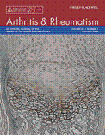Inflammatory lesions of the spine on magnetic resonance imaging predict the development of new syndesmophytes in ankylosing spondylitis: Evidence of a relationship between inflammation and new bone formation
Dr. Maksymowych is a Scientist of the Alberta Heritage Foundation for Medical Research.
Dr. Maksymowych has received consulting fees, speaking fees, and/or honoraria from Schering-Plough, Amgen/Wyeth, and Abbott (less than $10,000 each).
Abstract
Objective
To determine whether a vertebral corner that demonstrates an active corner inflammatory lesion (CIL) on magnetic resonance imaging (MRI) in patients with ankylosing spondylitis (AS) is more likely to evolve into a de novo syndesmophyte visible on plain radiography than is a vertebral corner that demonstrates no active inflammation on MRI.
Methods
MRI scans and plain radiographs were obtained for 29 patients recruited into randomized placebo-controlled trials of anti–tumor necrosis factor α (anti-TNFα) therapy. MRI was conducted at baseline, 12 or 24 weeks (n = 29), and 2 years (n = 22), while radiography was conducted at baseline and 2 years. A persistent CIL was defined as a CIL that was found on all available scans. A resolved CIL was defined as having completely disappeared on either the second or third scan. A validation cohort consisted of 41 AS patients followed up prospectively. Anonymized MRIs were assessed independently by 3 readers who were blinded with regard to radiographic findings.
Results
New syndesmophytes developed significantly more frequently in vertebral corners with inflammation (20%) than in those without inflammation (5.1%) seen on baseline MRI (P ≤ 0.008 for all reader pairs). They also developed more frequently in vertebral corners where inflammation had resolved than in those where inflammation persisted after anti-TNF treatment. This was confirmed in the analysis of the prospective cohort, in which significantly more vertebral corners with inflammation (14.3%) compared with those without inflammation (2.9%) seen on baseline MRI developed new syndesmophytes (P ≤ 0.003 for all reader pairs).
Conclusion
Our findings indicate that a syndesmophyte is more likely to develop from a prior inflammatory lesion, supporting a relationship between inflammation and ankylosis.




